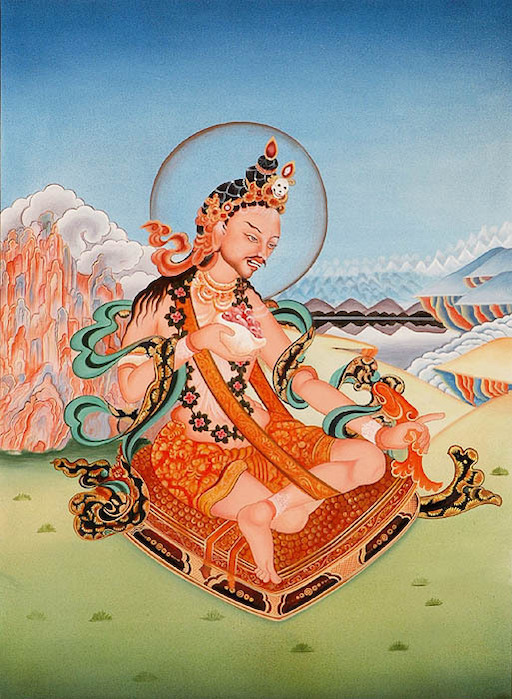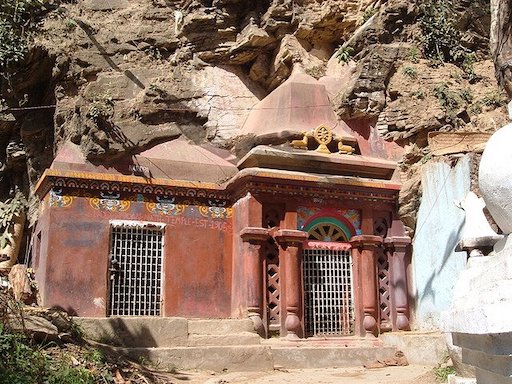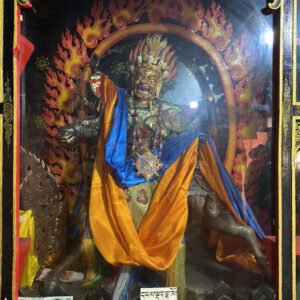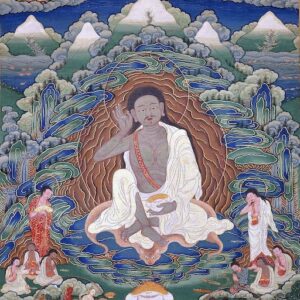This is the sadhana place of Tilopa. There is a place to sit and meditate up to 4 people at once inside the cave at once. You can go into meditative states here effortlessly. Naropa, Tilopa & Bhairavi Caves are next to each other. If they are locked, you can ask the caretaker to open the caves.
How to get there
From Pashupatinath cremation grounds, walk upstream along the left banks of Bagmati River. As you walk upstream, you will see the entrance towards the left.
The cave of Naropa and his guru Tilopa is beside Pashupatinath temple, bank of the holy Bagmati River. Two different caves of Tilopa and Naropa are Cave is considered as the holy site because the cave is the place where Naropa received training and teaching from his Guru Tilopa and he had visions of Vajrayogini here. Tilopa, his Guru, also meditated in the cave just next to it. Vajrayogini appeared again and again to the Great Mahasiddha Naropa giving teachings. Naropa, after practicing these teachings attained perfect knowledge and wisdom.
Map: https://goo.gl/maps/Lgt71jVsApqbX1Gf8
About Tilopa:
Tilopa (Prakrit; Sanskrit: Talika or Tilopada, 988–1069) was born in either Chativavo (Chittagong), Bengal or Jagora, Bengal. He was a tantric practitioner and mahasiddha. He developed the mahamudra (Tibetan: phyag rgya chen po) method, a set of spiritual practices that greatly accelerates the process of attaining bodhi (enlightenment).
He is regarded as the human founder of the Kagyu lineage of Tibetan Buddhism and is, in effect, the Buddha Vajradhara.
Tilopa was born into the brahmin (priestly) caste – according to some sources, a royal family – but he abandoned the monastic life upon receiving orders from a dakini (female buddha whose activity is to inspire practitioners) who told him to adopt a mendicant and itinerant existence. From the beginning, she made it clear to Tilopa that his real parents were not the persons who had raised him, but instead were primordial wisdom and universal voidness. Advised by the dakini, Tilopa gradually took up a monk’s life, taking the monastic vows and becoming an erudite scholar. The frequent visits of his dakini teacher continued to guide his spiritual path and close the gap to enlightenment. He began to travel throughout India, receiving teachings from many gurus:
- from Saryapa he learned of inner heat (Sanskrit: caṇḍalī, Tib. tummo, inner heat);
- from Nagarjuna he received the radiant light (Sanskrit: prabhasvara) and illusory body (Sanskrit: maya deha, Tib. gyulu) teachings (refer Chakrasamvara Tantra), Lagusamvara tantra, or Heruka Abhidharma);
- from Lawapa, the dream yoga;
- from Sukhasiddhi, the teachings on life, death, and the bardo (between life states, and consciousness transference) (phowa);
- from Indrabhuti, he learned of insight (prajna);
- and from Matangi, the resurrection of the dead body.
During a meditation, he received a vision of Buddha Vajradhara and, according to legend, the entirety of mahamudra was directly transmitted to Tilopa. After having received the transmission, Tilopa embarked on a wandering existence and started to teach. He appointed Naropa, his most important student, as his successor.
Six Words of Advice Tilopa gave Naropa a teaching called the Six Words of Advice, the original Sanskrit or Bengali of which is not extant; the text has reached us in Tibetan translation. In Tibetan, the teaching is called gnad kyi gzer drug – literally, “six nails of key points” – the aptness of which title becomes clear if one considers the meaning of the English idiomatic expression, “to hit the nail on the head.” According to Ken McLeod, the text contains exactly six words; the two English translations given in the following table are both attributed to him.
Source: http://www.tamqui.com/buddhaworld/Tilopa




